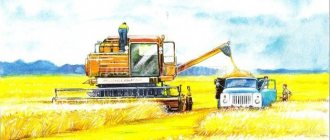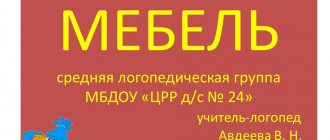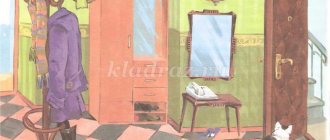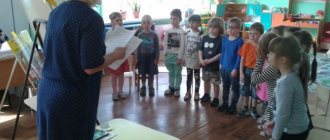Game 6. Speech game “Riddles - descriptions of mushrooms”
This game develops children's coherent speech, teaches them to express their thoughts sequentially, “read” the plan in pictures and compose a text according to the plan.
The usual description of any mushroom can be done according to this plan in pictures
Description of mushrooms: plan in pictures
For example: “This mushroom is called boletus. The boletus can grow very large. His hat is bright orange, very bright, strong, smooth. Like a red cap on your head. That is why it is also called “redhead”. The leg of the boletus is grayish-white, strong, plump. Boletuses grow in the forest under aspen trees. This is an edible mushroom. You can make soup from it, you can fry boletus mushrooms, you can make mushroom cutlets or mushroom gravy, pies.”
Riddle - the description differs from the usual description of a mushroom in that the driver does not say the name of the mushroom. You need to guess what kind of mushroom it is from the description.
You can even play the game on the road or in transport. The driver describes a mushroom. Guessers guess what kind of mushroom it is. If the description is not very detailed, then they can ask additional questions to the driver.
To make a wish, you can take a set of pictures “Mushrooms” (the download link is given above).
Plan of the riddle - descriptions of the mushroom
The easiest way for a child to create a riddle is with a plan in pictures:
- what size mushroom is it,
- description of the hat,
- description of the leg,
- where it grows,
- what can be made from it,
- final question: “Guess what kind of mushroom”
An example of a riddle - a description of a mushroom: This is a small mushroom. It always grows next to other similar mushrooms - like a family. The mushroom has a smooth, orange cap with a carved edge. And his leg is thin. This mushroom grows in mixed forest. This is an edible mushroom. You can prepare many delicious dishes from it: (listing dishes known to the child). Guess what kind of mushroom this is?” (chanterelle)
First, the adult asks the riddles to the child, and then the child will be able to tell you similar riddles. If it is difficult for him to construct the text of the riddle, then help your child:
a) asking the beginning of phrases: “What kind of hat does he have? And his leg... This is a mushroom..."
b) questions based on pictures - plans: “What kind of cap does this mushroom have? Where does it grow”, etc.
all the educational information about mushrooms in the article “Mushrooms in fairy tales, stories, pictures, videos and tasks for children”
How to choose the right riddles about mushrooms according to the child’s age, how to compose a riddle about a mushroom together with your child , 95 riddles with answers and pictures can be found in the article “Riddles about mushrooms.”
Game 1. Grammar game “What is cooked from mushrooms”
The game will teach the child word formation - the ability to form a new word by analogy (following a model), for example:
- soup, sauce, salad - mushroom,
- noodles, filling, caviar, mushroom casserole,
- cutlets - mushroom,
- all dishes that the chef prepares from mushrooms are mushroom dishes (mushroom salads, mushroom sauces, mushroom casseroles).
and also develops the child’s linguistic sense.
Part 1. Invite the children to imagine that they are now not children, but... cooks! You can put a real white cap on the child's head. If you don’t have a cap, you can use a paper chef’s badge on a string (hang the badge around your neck like a medal). You can download the Little Chef Medal
Or you can use “magic”: say “magic words” in unison (“Turn around once or twice. Quickly turn into a cook!”) and even wave your magic wand.
Now we are chefs! The cook knows how to cook different dishes. And every dish he makes is very tasty, beautiful, aromatic. Today, chefs prepare dishes from mushrooms.
What can be made from mushrooms?
Now we will make mushroom soup. It is called…. How? ( mushroom soup ). What do we put in it? (list products). Remember with your children how mushroom soup is cooked.
Ask - is the soup fried or boiled? If it is boiled, then what is it cooked in - in a frying pan or in a saucepan? Is it possible to cook soup in a frying pan? Why? While playing, we depict all the actions: take an imaginary “pan,” cut mushrooms, put them in the pan, etc. We inhale the aroma of the resulting soup and figure out who we will treat it to. You can immediately “pretend” treat the toys and each other and praise the soup (you will find words and descriptions of the dishes a little lower in this article).
You can also make... caviar from mushrooms! What will it be called? Mushroom caviar - what kind of game is this? If the child finds it difficult to answer this question, then tell him: “Caviar from zucchini - zucchini caviar. Eggplant caviar - eggplant caviar. And mushroom caviar is what caviar is. ..?” (questioning intonation and pause for the child to answer). Correct answer: mushroom caviar.
We depict with actions (pantomime) how we all make mushroom caviar together: we cut mushrooms and vegetables. fry them, put them in jars, close them with lids, put them in the refrigerator for storage (This is important: all actions are depicted “for fun”, pantomime is a game! In this game, there is no need to require the child to screw real lids on the jar, sign the jar, count , how many pieces of vegetable he put in it - the baby should be focused exclusively on speech and speech tasks. Everything else is done as in a regular game - in a folded form - “as if” we took the jar, “as if” we put it on a shelf)
Today we, the cooks, have another order - to make a casserole with mushrooms for the kindergarten. What should we call it? Potato casserole is potato casserole, cabbage casserole is cabbage casserole, and mushroom casserole is what kind of casserole? What is it called? ( mushroom casserole ).
The last order is to make a salad with mushrooms for the squirrel’s birthday. Salad with mushrooms is called... what do you call it? ( mushroom salad ). Let's come up with an interesting name for our mushroom salad: “Squirrel Joy”, “Mushroom Basket” (come up with a name with your child and the name, and what you put in the salad for the squirrel and depict how you and your child prepare it).
Now let's bake some pies. And we will also have mushroom filling. What is this filling called? Mushroom. These are pies with mushroom filling.
You can also make noodles from mushrooms! It’s called “ mushroom noodles ” or cook mushroom sauce - what is it called? ( mushroom sauce) You probably already guessed what the mushroom cutlets are called? Mushroom cutlets !
And the gravy with mushrooms is called... what? ( mushroom sauce)
Mushroom stew - what do you call this stew? ( mushroom stew )
After the children and I have “made” all the dishes, we share our impressions. You can “praise” your favorite dish: “I have mushroom cutlets - delicious, crispy, crispy.” “And I have ready-made pies with mushroom filling, decorated with dough braids,” and so on. You can “brag” one by one, or you can all come up with a way to “praise” your dish, choosing as many words as possible - descriptions. Help the children find meaningful words to describe these dishes.
An approximate dictionary for describing dishes and developing the expressiveness of children's speech in this game:
hot, warm, soft, fresh, fried, baked, flaky, tasty, rosy, aromatic, fragrant, tasty, crispy, grainy, juicy, sweet, salty.
Useful idea for child development:
Show your child at home how you cook mushroom soup and name all your actions as you go.
Verb dictionary for this comment:
- I wash it, clean it, cook it, put it in, cut it, cut it into pieces, grate it, put it on the fire, remove it, stir it.
- actions with mushrooms: mushrooms are dried, pickled, stewed, cut, salted, fried, and made into soup.
Such commentary will be very useful for the development of the child’s speech. Research shows that children who frequently hear the correct forms of words do not make mistakes in their use in speech. The words “rub” (tru - trem -tret), “clean” (clean - clean - clean), “cut” (cut, cut, cut) are not as simple for children as they seem to us. By explaining what you are doing, you simultaneously develop the child’s speech and prevent typical speech errors such as “rubbing” instead of “rub”, “cleaning” instead of “cleaning”, “mixing” / “kneading” instead of “interfering”, “laying down” instead of “ I’m putting it.” Involve your child in your actions and ask: “Do you want to wash with me? What are you doing right now? What am I doing? Yes, you wash, I wash. You and I wash the vegetables together. What vegetable are you washing? Which vegetable have you already washed? Which one will you wash now? What a wonderful helper you are! Thank you for your help!".
Part 2. At the end of the game, ask the children a grammatical riddle: “Guess what I asked:
The riddle is aimed at developing linguistic flair and the ability to agree in gender between adjectives and nouns.
Mystery:
- fresh, tasty, aromatic - is it caviar or salad? (If the child answers “Mushroom salad,” then ask him again: “Do we really say that: delicious mushroom salad? No! As we say about salad: delicious mushroom salad. So, what is it?”)
— fresh, fragrant, delicious — is it a soup or a casserole? Right! What would we say about the casserole? A fragrant delicious casserole,
- Mushrooms are delicious and aromatic - are these cutlets or pie?
Helpful Tips:
— Don’t forget to turn the children from chefs back into ordinary preschoolers at the end of the game :). This can also be done with the simplest “magic words”: “One, two, turn around!” Turn into Misha (child’s name) again!” or “One, two, spin! Find yourself home again!”
— When playing with children, do not forget that cooks behave in accordance with their profession and do not behave like children. They can't throw a pan on the floor or chop mushrooms carelessly. Therefore, try to convey the peculiarities of the cook’s movement yourself, and the children will imitate you. The main thing is to treat your child in this game like a real chef - very respectfully, ask him for advice, be interested in his opinion, you can even call him by his first name and patronymic: “Dear Mikhail Grigorievich, can we already start making mushroom caviar? Okay, let's begin then. What do we need? Don't step out of your role!
- If the child begins to behave differently from the cook, remind him that he is not a boy/girl now, but the cook and his dish are very, very waiting (name who is waiting and why his dish is needed). Therefore, you need to try and “cook” it tasty so that people are happy and eat it with pleasure. This is often enough for the child to remember his role in the game.
- Second version of the game: the second time you play this game, change it and play it in the second version.
In the second version of this game, children will learn to use nouns in the genitive case: from chanterelles (and not “from chanterelles” - this is a mistake), from boletus, from volnushek, from boletus, and so on.
For this option you will need “Mushrooms” cards. You can download them for free in the article “Mushrooms. Pictures for children".
Place the cards face down on the table (You will need edible mushroom cards with several mushrooms on them). The roles of cooks are played by children players in turns.
Step 1. The cook takes a card and names the mushrooms shown on it. Decides what he will make from them: “I will cook mushroom soup.”
Step 2. Everyone guesses what he will use to make mushroom soup (or any other dish he has chosen): “Are you going to make mushroom soup from chanterelles? from champignons? from boletuses? from boletus?” until they guess. Everyone guesses one by one.
When the player has guessed, the presenter shows his card and confirms the correctness of the answer, for example: “Yes, I will cook chanterelle mushroom soup.”
You can introduce the following rule of the game: add “penalty” pictures—poisonous mushrooms—to your set of cards. If a child recognizes an inedible mushroom and immediately says: “I have a poisonous mushroom. This is...(name of mushroom)", then he can take a new card. And continue to participate in the game. If he does not recognize the poisonous mushroom and “cooks” a soup or other dish from the poisonous mushroom in the game, then he misses his turn in the next round. Or he pays forfeit.
how to introduce your child to edible and poisonous mushrooms from the article “Mushrooms in fairy tales, stories, pictures, tasks and educational videos for kids.”
The game can be played in pairs, in a small subgroup of children, or with a large group of children. If you play with a large group of children, then the children play as one team. For example, one child - the leader - chooses a card. And the whole group of children guesses what is depicted on it. If the leader, the cook, makes a mistake, then a group of children corrects him, for example: “No, you need to cut it first and then put it in the soup.” Then a new leader is selected by counting.
MAGAZINE Preschooler.RF
Summary of educational activities for speech development in the senior group using ICT “Mushrooms in the autumn forest”Integration of educational areas: “Cognitive development” , “Speech development” , “Socio-communicative development” , “Physical development” .
Tasks:
1. Consolidate ideas about the forest.
Introduce the names of mushrooms, their external characteristics, structure ( “Cognitive development” )
2. Clarification, expansion and activation of the dictionary on the topic “Mushrooms” . Learn to coordinate numerals with nouns, form adjectives from verbs; consolidate the use of prepositions. ( "Speech Development" )
3. Formation of skills of cooperation, mutual understanding, goodwill, independence, responsibility. Fostering love and respect for nature. ( "Socio-communicative development" )
4. Development of visual attention and perception, coordination of speech with movement. ( "Physical development" )
Preliminary work: reading a fairy tale and watching the cartoon by V. Suteev “Under the Mushroom” .
Equipment: baskets, handout cards with images of edible and inedible mushrooms, dummies, tape recorder, recording “Voices of the Forest” , “hemp” (modules), subject pictures “Mushrooms” (boletus, boletus, chanterelles, fly agaric, toadstool, camelina, white mushroom, butterdish, honey fungus), “Mushrooms” .
ICT tools: presentation, projector, screen.
Methodological techniques.
- Creating an entertaining situation.
- Methods of verbal transmission (explanation, story, conversation)
- Visual methods (observation, showing a sample, showing a method of action and teaching aids.
- Game methods (finger gymnastics, physical education, breathing exercises)
Logic of educational activities:
I. Organizational moment.
1) Greeting.
- Hello guys!
2) Motivation for the lesson.
Emotional mood: the recording of “Voices of the Forest”
Educator: Guys, today I want to offer you a trip to the autumn forest. And to get to the forest, you need to take a bus and go far from the kindergarten.
And during our journey, I invite you to guess the riddle.
Who stands on a strong leg? In the brown leaves by the path? It looks like an umbrella, only a hundred times smaller.
If there is a thunderstorm on the horizon, He is very happy, If it is raining and warm, He considers himself lucky!
-Children's answers. (Mushroom)
Educator: Correct! We'll go mushroom hunting today. What can we find out about them in the forest?
Children: names of mushrooms, where they grow, how to collect them.
Educator: Okay. We'll find out.
Guys, here we are. (we get off the bus).
Here is the forest. Hello forest, dense forest, full of fairy tales and miracles.
Guys, remember we read a fairy tale and watched the cartoon “Under the Mushroom” . What surprised the ant when the rain stopped and he got out from under the mushroom?
Children: At first there was not enough room for one ant, but then there was a place for everyone.
Educator: How did it happen that at first it was cramped under the mushroom and alone, and then
Was there a place for all five?
Children: While it was raining, the mushroom grew.
Educator: That's right, mushrooms grow after rain.
It is not without reason that the proverbs say: “If there is rain, there will be mushrooms . And at what time of year are there the most mushrooms?
Children: In autumn.
Educator: And there is a proverb about this: “Spring is red with flowers, and autumn is red with mushrooms .
-You and I have found ourselves in the real kingdom of mushrooms.
Mushrooms are very diverse. Can all mushrooms be picked?
Children: no, there are edible and inedible (poisonous)
Educator: why are mushrooms called inedible?
Children: They should not be eaten.
Educator: Correct! Remember that not every mushroom goes into the basket. There are mushrooms that are poisonous (inedible). They contain poison that can cause poisoning. You should only collect mushrooms that are well known to you. And about those who put poisonous mushrooms in the box, they say: “Walking in the forest means seeing death right on your nose . Please look at the pictures and try to determine which mushrooms are inedible.
Children: fly agaric.
Educator: Correct, but there is also a pale toadstool, false honey mushrooms.
(Demonstration and story by the teacher).
Fly agaric is the most common poisonous mushroom. The leg is long, there is a white collar. The hat is red, round, with white speckles.
Near the forest on the edge, decorating the dark forest, a poisonous fly agaric, as colorful as parsley, grew.
Red hat with polka dots, collar on a thin stem. This mushroom is beautiful to look at, but dangerous and poisonous.
Isn't that right, handsome? Scarlet caftan, white specks.
“The fly agaric is red, but dangerous for health . But don’t rush to knock down fly agarics with your feet and trample them. In the forest, fly agaric is a necessary mushroom. It is poisonous to humans, but suitable for forest dwellers. Deer greedily search for fly agarics and eat them. Snails and slugs gnaw holes in the caps of fly agarics. Squirrels even dry them for the winter. For medicinal purposes. People, by the way, have also already learned to use fly agarics as a cure for some serious diseases.
Pale toadstool is a deadly poisonous mushroom. The leg is long, at the root there is a sac from which the mushroom grows, the collar, cap is round, uneven,
pale in color. I'm not used to being liked. Anyone who eats me will get poisoned.
Guys, I ask you to look carefully at the pictures and remember the poisonous mushrooms.
Finger gymnastics “Mushrooms” One, two, three, four, five! “Walking” with their fingers on the table
We are going to look for mushrooms (They begin to bend one finger at a time
This finger went into the forest, This finger found a mushroom, This finger began to clean, This finger began to fry,
This little finger ate everything and that's why he got fat.
Educator: Mushroom picking is called “silent hunting” . We are not masters in the forest, but guests. And since you’ve already come to visit, respect the owners of the forest: the plant and animal forest people. For regular hunting they go with guns, and for mushroom hunting - with knives.
But before picking mushrooms, we must learn the rules for picking mushrooms:
- Mushrooms can only be collected with adults who know the forest well;
- Do not pick or trample poisonous mushrooms - many forest inhabitants need them;
- Do not dig up the mycelium with a stick—it may dry out without being covered with leaves;
- Do not pick mushrooms near the roadway;
- Collect only known mushrooms;
- Do not pick old or very small mushrooms.
- Cutting the mushrooms carefully with a knife, rather than picking them, can damage the mycelium.
What is mycelium?
Children: find it difficult to answer.
The teacher gives the concept of mycelium.
Educator: Mushrooms should not be picked, but cut. And for what?
Children: In order not to pull out the mycelium - the roots of the mushrooms. Without mycelium, new mushrooms will not grow.
Educator: That’s right, mushrooms cannot be pulled out of the ground along with the mycelium. Having destroyed the mycelium, you will no longer find mushrooms in this place. But the mycelium of some mushrooms live for hundreds of years! If you find a forest treasure - a young fresh mushroom, you need to cut it off with a knife. Lightly sprinkle the mycelium with soil, cover it with leaves or a branch of pine needles and press firmly with your palm so that the mushroom grows again next year. A real mushroom picker, when he finds a good mushroom, will first admire it, remember where this mushroom grew, and only then carefully cut it off and put it in a basket with the cap down. These are the gifts the forest gives us!
Now, you mushroom pickers. Let's walk quietly through the forest, inhale the fresh smell of fallen leaves (breathing exercises), and collect mushrooms. We carefully look at our feet, lift the lower branches (collect mushrooms). Children get up and walk around the room, finding arranged mushrooms (dummies) and putting them in a basket.
Then the children sit on the “stumps” (arranged in a semicircle)
Educator: How can you describe in one word what you collected?
Children: Mushrooms.
Teacher's story about mushrooms.
Mushrooms grow in the forest: in clearings, on the edges, under trees, in the grass and even on stumps. Mushrooms have a cap and a stalk.
The teacher shows one mushroom at a time and describes with the child the appearance and structural features (size, shape and color of the cap and stem, growth characteristics)
WHITE MUSHROOM - the cap is brown, round, the stem is thick. I’m used to standing in a remote forest.
Pictures upon request white mushroom
BEREOZOVIC - grows mainly under birch trees, the cap is round, the stem is thin, tall, the cap is dark brown.
Pictures upon request: boletus under a birch tree
Aspen Boletus - with a red hat, high leg.
Pictures upon request boletus
CHANTERELLE - yellow in color, with a low stem, concave cap.
Pictures upon request of foxes
MUSCHINES - light brown mushrooms on thin stalks with a “collar” , grow in “families” .
Pictures upon request honey mushrooms
Where do honey mushrooms like to grow? (Children's answers). That's right, on the stumps. The word "honeycomb" comes from the word "stump" . You can collect a whole basket of honey mushrooms from one stump.
This is OIL
Pictures upon request Boletus in the forest
The guys are so friendly that whole families climb out of the ground. Butterflies are pine babies. This means what kind of trees do they like to grow under?
Children: Under the pines.
Educator: Look, both a blade of grass and a needle are stuck to the butter hats. Why?
Children: probably because they are sticky and oily.
Educator: Yes, because their hat is shiny and sticky, as if greased with oil. Very tasty boletus mushrooms.
Introduce children to polysemantic words: chanterelles, hat, leg.
Explain the difference in the meanings of these words. By comparison.
Physical education minute:
All the little animals at the edge of the forest were looking for milk mushrooms and milk mushrooms, squirrels were jumping, saffron milk caps were being picked. The little fox ran, collected little foxes, the little bunnies galloped, looking for honey mushrooms. The bear passed by and crushed the fly agaric.
Educator: Guys, after we have collected the mushrooms, can we eat them right away?
Children's answer: No.
Educator: They need to be cooked, so we’ll find out if you know how to cook mushrooms.
Exercise “What mushrooms” (learning to form verbal adjectives).
- If you boil mushrooms, they will be boiled
- and if you fry mushrooms, then they will be fried
- if you pickle them, they will be salted, - if you pickle them, they will be pickled, - if you dry them, they will be dried.
Educator: how many mushrooms we collected! Let's count them.
Exercise “Count” (to coordinate numerals with nouns)
1 mushroom,.., 3…, 5… 1 chanterelle 3…, 5… 1 honey mushroom, 3…, 5…
Educator: Guys, our walk has come to an end, it’s time to return to kindergarten. Please go to the bus and take your seats.
Final part.
Educator:
And on the way back, we will sum up the results of our walk.
What new have you learned? What types of mushrooms are there? Which mushrooms can you pick and which ones can’t? (Children's answers)
Children: Where mushrooms grow, edible and inedible, parts of a mushroom, rules for collecting mushrooms.
Educator: Well done! (Adds)
And at home, I will ask you and your parents to clarify why you can’t pick mushrooms near the roadway and near factories and factories?
Educator: Guys, you and I followed all the rules of the forest and the forest inhabitants decided to thank us. They handed you treats.
Mushroom cookies to children .
| Next > |







